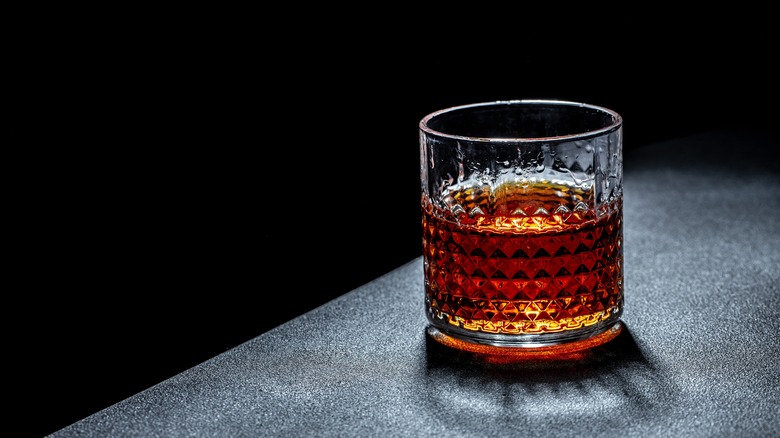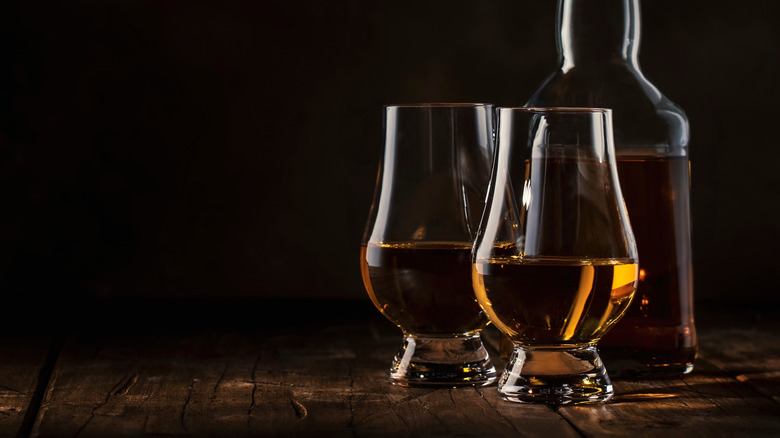The Reason You Shouldn't Call Bourbon 'Smooth' At A Tasting
Smooth is often a descriptor bourbon drinkers use — even after drinking harsh whiskey or feeling what's known as whiskey burn — but it's not a term to bring up at a bourbon tasting, or when you're among connoisseurs of the iconic American spirit.
It's not because it's necessarily inaccurate, mind you. Many bourbons are smooth, both because of the corn that is the primary ingredient (all bourbon, by law, must contain 51% or more corn) or because of years spent aging in charred new oak barrels. But the term "smooth" is pretty vague, and doesn't describe any of the flavors in a good bourbon that you might be trying to hone in on during a tasting. Not only that, but bourbon experts will judge you for using the term, as it adds zero to the discourse.
So what do you say to at least sound like you know what you're doing when ordering bourbon? For starters, you can say whether you like the brand you're trying. It's totally okay to keep it that simple, and it's also okay if you're not an expert and are just at the event because you like the taste of bourbon. But, in tasting situations, you're better off referencing specific flavors and feels in more detail.
How to taste bourbon like an expert
If you want to start developing language familiar to veteran bourbon tasters, building your vocabulary is important. For starters, you'll want to familiarize yourself with the term "Kentucky chew."
Kentucky accounts for 95% of all bourbon production. So it's only appropriate that the state also lends its name to the proper bourbon tasting method. The "Kentucky chew," according to Jim Beam Master Distiller Fred Noe (via Distillery Trail), is a way of swirling around the bourbon so that it's exposed to more of your taste receptors since different parts of your mouth will recognize different flavors.
There's more to it than that, however. A bourbon tasting is not dissimilar to a wine tasting in that you'll want to judge color (invariably, a good gauge of both intensity of flavor and alcohol content) and aromas before sipping the bourbon. After you've gone through all these steps, smooth probably won't be the first word that comes to mind. Instead, you can impress fellow tasters with more about the flavor notes such as fruit, floral, and spice.
How to talk about bourbon like an expert
The similarities between wine and bourbon tastings extend to the use of flavor wheels, which help tasters pick out common notes within a variety of categories. There's a good chance, for example, the bourbons you'll be tasting will exhibit fruitiness like apple or cherry, or floral flavors like rose petals, or spicy overtones of cinnamon or black pepper. The flavor wheel is also a good way to help familiarize yourself with standard wood-aging aromatics like chocolate, honey, vanilla, or caramel.
Most experienced tasters also learn the flavor profiles associated with the best-known bourbon distillers, as these provide a starting point in terms of building a base of knowledge that will come in handy during tasting evaluations or when ordering at a bar. Some brands, for example, are known for their fruit or floral forward bourbons, like Four Roses or E.H. Taylor, Jr. The former is also notable for making bourbons with flavor notes of dill and toasted oak.
But suffice to say, smooth is not on the flavor wheel. And while it's nice if your bourbon is smooth, as it sure beats the alternative, maybe just keep this thought to yourself during your next bourbon tasting.



